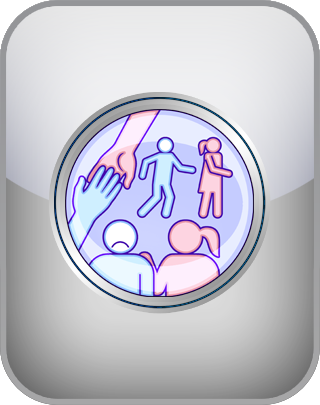Academically reviewed by Dr. Sabina Alispahić, Ph.D., professor of psychology
Separation Anxiety Test
Separation anxiety disorder (SAD) in adults is a mental health condition characterized by excessive fear or anxiety concerning separation from attachment figures, such as parents, partners, or close family members. While separation anxiety is commonly associated with children, it can also persist in adulthood and manifest as a disorder. Adults with separation anxiety disorder often experience intense distress when faced with situations that involve separation from others, leading to avoidance of activities or situations that may trigger these feelings.
Are you showing signs of separation anxiety disorder? For each of the following questions, indicate how well it applies to you.
Question 1 of 25
I have spent much time and energy to be prepared for separation from others.
| Disagree | Agree |
NEXT
The IDRlabs Separation Anxiety Test was based on the Diagnostic and Statistical Manual for Mental Disorders, 5th edition, and developed by IDRlabs.
The exact cause of separation anxiety disorder in adults is complex and likely involves a combination of genetic predisposition, brain chemistry imbalances, early life experiences, attachment styles, life transitions, personality traits, and stressful life events. Genetic factors may contribute to vulnerability, while imbalances in neurotransmitters like serotonin and dopamine may affect mood regulation. Traumatic childhood experiences, insecure attachment styles, and major life changes can also play significant roles. Stressful life events and ongoing stressors may exacerbate symptoms. However, individual differences in resilience and coping strategies can influence how individuals respond to these factors. Overall, separation anxiety disorder in adults is multifaceted and influenced by a variety of biological, psychological, and environmental factors.
In simple terms, separation anxiety disorder is when someone feels extremely worried or afraid when they're away from the people they're closest to, like family members or partners. It's like feeling really scared of being apart from them, even for a short time. This fear can be so strong that it affects daily life, making it hard to go places alone or do things without those important people nearby.
Diagnosing separation anxiety disorder typically involves a comprehensive evaluation by a mental health professional, such as a psychiatrist or psychologist. The diagnosis is based on a thorough assessment of the individual's symptoms, medical history, and personal circumstances. The mental health professional conducts a detailed interview to gather information about the individual's symptoms, their frequency and severity, any triggers or specific situations that provoke anxiety, and how these symptoms impact daily functioning.
Individuals with separation anxiety disorder may experience persistent and excessive worry about potential separation from their attachment figures. This worry may manifest as fear of something bad happening to the attachment figure or fear of being abandoned or left alone. These fears may become particularly intense when separation is anticipated, leading to avoidance of separation-inducing situations or excessive efforts to avoid being apart from loved ones.
Physical symptoms of anxiety may accompany the emotional distress associated with separation anxiety disorder. These symptoms can include trembling, sweating, nausea, stomachaches, headaches, or other signs of physiological arousal. These physical manifestations of anxiety may occur in anticipation of separation, during separation, or in response to thoughts or reminders of separation.
Avoidance behaviors are common in individuals with separation anxiety disorder. They may go to great lengths to avoid situations or activities that could potentially lead to separation from attachment figures. This may include reluctance or refusal to attend school or work, avoiding social gatherings or outings, or refusing to sleep away from home or in a separate room.
Individuals with separation anxiety disorder may cling excessively to their attachment figures when they are together, seeking constant reassurance and proximity to them. They may express intense distress or discomfort when separated from their attachment figures, even for short periods. This excessive clinginess and reluctance to be apart from loved ones can interfere with independence and autonomy.
Separation anxiety disorder can lead to significant distress or impairment in social, academic, or occupational functioning. The fear and worry associated with separation may interfere with the individual's ability to engage in everyday activities, form and maintain relationships, attend school or work regularly, or pursue personal interests and goals. This impairment can have far-reaching consequences and may contribute to feelings of frustration, isolation, or inadequacy. Overall, the symptoms of separation anxiety disorder encompass a range of emotional, physical, and behavioral manifestations that can profoundly affect an individual's well-being and functioning.
Treatment for separation anxiety disorder typically involves a multifaceted approach aimed at reducing symptoms and improving overall well-being. Cognitive-behavioral therapy (CBT) is often the primary intervention, focusing on identifying and challenging negative thoughts and beliefs related to separation, teaching coping skills to manage anxiety, and gradually exposing individuals to separation-inducing situations. Family therapy may also be beneficial, addressing family dynamics and communication patterns to foster a supportive environment and promote healthy attachment relationships.
In some cases, medications such as SSRIs or benzodiazepines may be prescribed to alleviate anxiety symptoms, while lifestyle modifications, including regular exercise, adequate sleep, and stress management techniques, can complement therapeutic interventions. Supportive interventions from loved ones, as well as school or work accommodations, may be necessary to help individuals manage symptoms while maintaining daily responsibilities. Overall, treatment requires a collaborative effort between the individual, their family, and mental health professionals to achieve optimal outcomes and long-term symptom management.
As the publishers of this free test, which allows you to screen yourself for the characteristics of Separation Anxiety Disorder, we have strived to make the test as reliable and valid as possible by subjecting this test to statistical controls and validation. However, free online quizzes such as the present test do not provide professional assessments or recommendations of any kind; the test is provided entirely “as-is.” For more information about any of our online tests and quizzes, please consult our Terms of Service.

